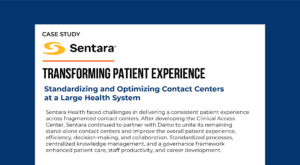Telehealth and other virtual care technologies usage tripled during COVID-19
– Ceci Connolly, President and CEO, Alliance of Community Health Plans
Our recent guest on The Big Unlock podcast was Ceci Connolly of the Alliance of Community Health Plans. Ceci discussed how COVID-19 has changed consumer behavior towards healthcare and how telehealth and other virtual care technologies are gaining momentum due to the current pandemic with Paddy Padmanabhan, CEO of Damo Consulting.
Listen to the full conversation
“We believe that the model of the health plans and the providers being really aligned around the patient and the community makes for a very successful approach in healthcare today. Our work really grows out of that belief and the view that a business model of payer-provider partnership is best for patients and communities.”
– Ceci Connolly, The Big Unlock, Episode #48
COVID-19 pandemic increased the use of telehealth and other virtual care technologies
The Alliance of Community Health Plans is a non-profit organization that brings together innovative health plans and provider groups delivering affordable, community-based, high-quality coverage and care. They have 25 member companies and are present in 35 states. A recent survey by ACHP on how COVID-19 has shifted consumer attitudes towards healthcare indicates that the use of telehealth tripled during the current pandemic and 89% of the respondents said that they were either highly satisfied or satisfied with the telehealth experience.
“This was a national survey of adults, and we were most interested in how the COVID-19 pandemic has altered patients’ views about going to a doctor’s office or hospital and how they are interested in receiving healthcare services now and in the future. A very sizable 72% of the respondents said that the pandemic had dramatically changed their use of healthcare services over the past few months. We consistently saw that through the early months of the crisis there was a high level of anxiety about going to a doctor’s office, a hospital, an urgent care clinic, or any of those in-person sites for elective procedures, diagnostic procedures, and tests. The good news of that is we saw a remarkable tripling of use of telehealth or virtual care in that time. 89% said they were satisfied or highly satisfied with the experience.
– Ceci Connolly
Virtual care at the core of the value-based model
Ceci states that there have been many discussions and efforts around moving towards a value-based from a volume-based fee-for-service model. With more and more focus on virtual care, she hopes to see the virtual care model into the value-based approach. This approach will not only ensure well deserved rewards for outcomes as opposed to just number of procedures but will also help improve healthcare outcomes for patients by taking key inputs from clinicians and patients.
“We always try to start with the evidence and clinicians’ wisdom when it comes to the appropriateness of care. What cares are being delivered, when, how, where, etc. There’s been talk and effort in this country for a long time about moving from our volume-based fee-for-service system to a value-based system that rewards outcomes as opposed to just number of procedures, and I would certainly put virtual care into the value-based model approach.” – Ceci
“If a clinician has a diabetic patient, they should be able to think through how much of that can be remote monitoring, emailing, the occasional video check-in. We have seen that in so many of the delivery systems, physician group practices, hospitals, et cetera, that they were so heavily reliant on volume-driven revenue and fee-for-service that they encountered very severe cash shortages very quickly in the crisis. If you were to talk to clinical teams, physician groups in more value-based arrangements, they continued to receive those steady payments throughout the crisis.” – Ceci
Shift of in-person visits to virtual visits in healthcare
ACHP’s survey clearly indicates that the healthcare industry is transitioning from in-person to virtual care options. It is also estimated that 80-90% of outpatient care could shift to virtual care models in future. Ceci further mentions that in the post-pandemic era, healthcare payers will be committed more towards virtual care option for patients.
“I think that due to the COVID-19 crisis, people that otherwise could not get access to medical services, finally can have it with a click of a button on a device. Many of our health plans report that patients coming to scheduled appointments virtually is higher than the rates that they were seeing pre pandemic in person. I can tell you that the payers are very committed to the virtual care option for patients. They are now working to ensure that all the communications are going to sync up nicely with a person’s electronic medical records and everything is kind of tied together in a coherent fashion for the patient, clinical team, and other technology investments.” – Ceci














